Liberation of Auschwitz-Birkenau,
January 27, 1945
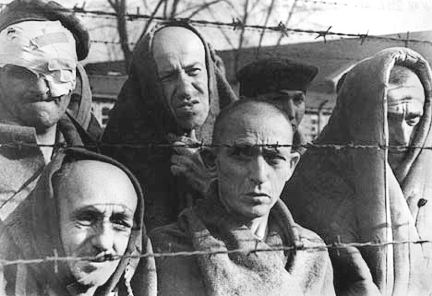 Prisoners liberated
at Auschwitz main camp
Prisoners liberated
at Auschwitz main camp
 Gypsy children at Birkenau
death camp
Gypsy children at Birkenau
death camp
In February 1945, shortly after the liberation
of the Auschwitz-Birkenau camp on January 27, 1945, the Soviet
Union made a film which showed the survivors of the camp. The
photos above are still shots from the film. The photo immediately
above shows Gypsy children who had allegedly been subjected to
Nazi medical experiments. Auschwitz Commandant Rudolf Hoess claimed
that these children were suffering from a disease called Noma
which was similar to leprosy.
The Soviet film showed male prisoners
who had allegedly been sterilized in medical experiments done
at the Auschwitz camp.
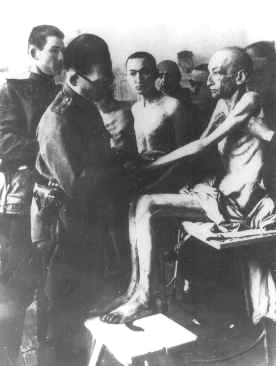 Soviet doctor examines
an Auschwitz survivor
Soviet doctor examines
an Auschwitz survivor
The photo below shows a young survivor
being cared for by a Soviet doctor wearing an arm band.
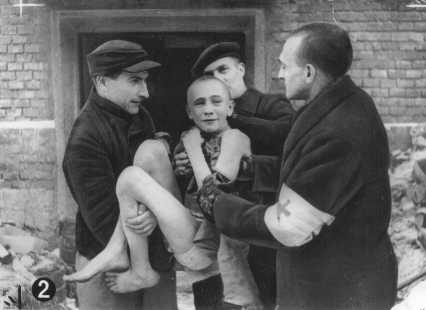 Soviet doctors carry
young survivor out of building at Auschwitz main camp
Soviet doctors carry
young survivor out of building at Auschwitz main camp
Only a few dead bodies, including some
that were lying in the snow, are shown in the Soviet film, and
there are no prisoners shown who were dying of typhus, as in
the Dachau or Bergen-Belsen camps.
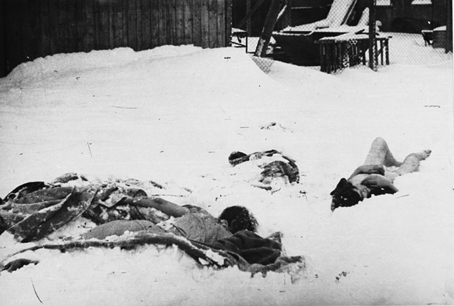 Dead bodies found in
the snow near the barracks at Birkenau
Dead bodies found in
the snow near the barracks at Birkenau
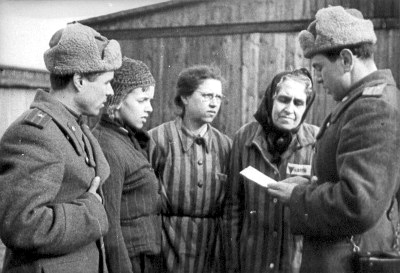 Soviet soldiers interview
survivors at the Birkenau death camp
Soviet soldiers interview
survivors at the Birkenau death camp
The Soviet movie about the liberation
of Auschwitz-Birkenau shows that few of the recently liberated
prisoners were cheering or smiling; some of them looked angry,
especially the woman in the photograph below, who is shown in
the movie standing perfectly still with a hostile expression
on her face. The film shows a whole crowd of survivors, wrapped
in heavy blankets, who appear to be angry or unhappy, maybe because
they had been dragged out of their beds to pose for the cameras.
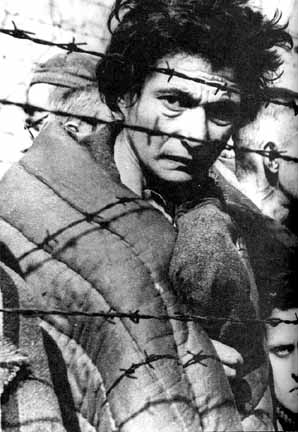
Auschwitz survivor
shown in Russian liberation movie

Hungarian Jewish women
arrive in Birkenau, May 26, 1944
The woman on the right in the front row,
the one wearing a black coat, might be the same woman who is
shown in the previous photo, standing at the barbed wire fence
after the liberation of Birkenau. If it is the same woman, she
has aged 10 years after being in the camp for only eight months.
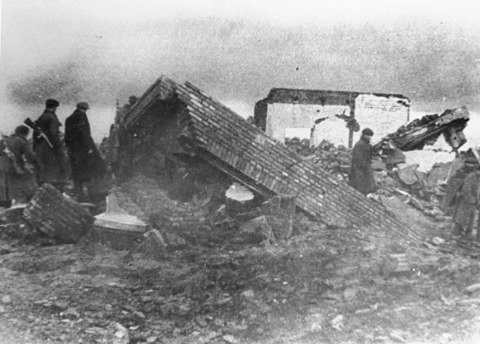 Ruins of gas chamber
at Birkenau, January 1945
Ruins of gas chamber
at Birkenau, January 1945
After the Germans had abandoned the Auschwitz-Birkenau
complex and marched thousands of the prisoners out on January
18, 1945, they came back on January 20 and blew up two of the
crematoria buildings where the underground gas chambers were
located. The photo above shows the ruins of one of these buildings
with an unidentified building still standing in the background.
The ruins of two of the gas chamber buildings
are shown in the two photos below.
 Ruins of gas chamber
building #2 at Birkenau
Ruins of gas chamber
building #2 at Birkenau
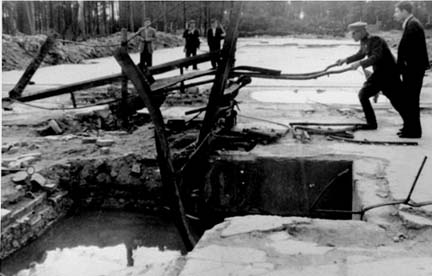
Ruins of gas chamber
building #5 at Birkenau
This page was last updated on January
01, 2010
|